| Test: | Able |
|---|---|
| Time: | 17:00 1 April 1952 (GMT) 09:00 1 April 1952 (local) |
| Location: | Nevada Test Site (NTS), Area 5 |
| Test Height and Type: | 793 Foot Airdrop from B-50 |
| Yield: | 1 kt |
This device used the same U-235 core design first tested in Ranger Able. This design had become something of an experimental benchmark due to its convenient low yield and high predictability, having also been used in Jangle Sugar and Jangle Uncle. The Mk 4 based test device weighed 10,800 lb.
What are Those Smoke Trails Doing in That Test Picture?
| Test: | Baker |
|---|---|
| Time: | 17:30 15 April 1952 (GMT) 09:30 15 April 1952 (local) |
| Location: | Nevada Test Site (NTS), Area 7 |
| Test Height and Type: | 1109 Foot Airdrop from B-50 |
| Yield: | 1 kt |
This device also used the Ranger Able U-235 core in a Mk 4 based test device (weight 10,500 lb).
| Test: | Charlie |
|---|---|
| Time: | 17:30 22 April 1952 (GMT) 09:30 22 April 1952 (local) |
| Location: | Nevada Test Site (NTS), Area 7 |
| Test Height and Type: | 3447 Foot Airdrop from B-50 |
| Yield: | 31 kt |
This test combined a proof test of a new high-efficiency core with blast effects measurements. The predicted yield was 40-60 kt. This test was broadcast live on television (a first). The Mk 4 based test device weighed 10,440 lb.
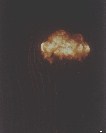 Tumbler Charlie (probably, whether this is Tumbler Charlie or Buster Charlie is uncertain) (16 K)
Tumbler Charlie (probably, whether this is Tumbler Charlie or Buster Charlie is uncertain) (16 K)
Operation Snapper
This was an ambitious series to evaluate new weapon design principles and gather fundamental weapon design data. Among the new features tested included deuterium gas fusion boosting, external initiation, and the use of beryllium neutron reflector/tampers. Tests of new smaller implosion systems, and new schemes for achieving high core compression were also conducted. Other experiments calibrated the TOM internal neutron initiator, provided initiation time vs yield calibration data, and explored the curious "rope trick" effect seen with cable moored test devices.
| Test: | Dog |
|---|---|
| Time: | 16:30 1 May 1952 (GMT) 08:30 1 May 1952 (local) |
| Location: | Nevada Test Site (NTS), Area 7 |
| Test Height and Type: | 1040 Foot Airdrop from B-45 |
| Yield: | 19 kt |
Dog was a test of a modified TX-7 weapon (previously tested in Buster Easy). The device tested the usefulness of deuterium gas fusion boosting (not deuterium-tritium boosting!). The predicted yield was 15-20 kt.
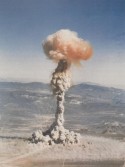 |
| Test: | Easy |
|---|---|
| Time: | 12:15 7 May 1952 (GMT) 04:15 7 May 1952 (local) |
| Location: | Nevada Test Site (NTS), Area 1 |
| Test Height and Type: | 300 Foot Tower |
| Yield: | 12 kt |
This device (code named BROK-1) was a test of the TX-12, a Mk-12 bomb prototype. The Mk-12 was intended to be a slender, lightweight tactical bomb that could be carried externally by high speed fighter-bombers. It set a record at the time for small diameter and light weight, with an implosion system diameter of 22 inches weighing only 550 lb (a modest improvement over the Mk-7), yet retained good compression and efficiency. The total device weight was 625 lb, with a predicted yield of 9 kt.
| Test: | Fox |
|---|---|
| Time: | 12:00 25 May 1952 (GMT) 04:00 25 May 1952 (local) |
| Location: | Nevada Test Site (NTS), Area 4 |
| Test Height and Type: | 300 Foot Tower |
| Yield: | 11 kt |
This device (code named XR1) used a Mk 5 bomb assembly. The test was intended to gather data on the initiation time vs yield curve; it also served as a calibration test of the TOM polonium-beryllium internal neutron initiator. The test device had a diameter of 40 inches and weighed 2700 lb, the predicted yield was 15-18 kt.
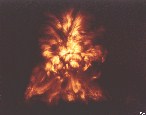
Snapper Fox, 584x460 (36 K)
Larger size, 628x721 (70 k)
| Test: | George |
|---|---|
| Time: | 11:55 1 June 1952 (GMT) 03:55 1 June 1952 (local) |
| Location: | Nevada Test Site (NTS), Area 3 |
| Test Height and Type: | 300 Foot Tower |
| Yield: | 15 kt |
This device (code named XR2) used a Mk 5 bomb assembly. The test was intended to gather additional data on the initiation time vs yield curve. A novel feature of this test was the use of an external initiator - in this case employing a device called a betatron (which is a circular electron accelerator). In this test the high energy electrons were used to generate high energy X-rays that induced photo-fission in the core to initiate the chain reaction. The betatron allowed very accurate control of initiation time. The test device had a diameter of 40 inches and weighed 2700 lb, the predicted yield was 30 kt.
| Test: | How |
|---|---|
| Time: | 11:55 5 June 1952 (GMT) 03:55 5 June 1952 (local) |
| Location: | Nevada Test Site (NTS), Area 2 |
| Test Height and Type: | 300 Foot Tower |
| Yield: | 14 kt |
This device (code named Scorpion) was designed in part by Ted Taylor. Snapper How was the first test to use a beryllium neutron reflector/tamper, which would become standard in later weapons. The test device used the same 22 inch implosion system as Snapper Easy, but the lightweight tamper cut 80 pounds off the implosion system weight. Predicted yield was 11 kt.
"Rope Tricks"
The image below shows the growing fireball, taken about one millisecond after detonation, for one of the Snapper tower shots (I haven't been able to find out which one yet). There are two striking features about this picture - the spikes projecting from the bottom of the fireball, and the ghostly mottling of the fireball surface.
The peculiar spikes are extensions of the fireball surface along ropes or cables that stretch from the shot cab (the housing for the test device at the top of the tower) to the ground. This novel phenomenon was named a "rope trick" by Dr. John Malik who investigated it. The effect had been observed in earlier tests when spikes were seen extending along cables that moored the shot towers to the ground. During Snapper Malik conducted experiments using different kinds of cables and ropes, and with different surface treatments. Consequently the spikes in this picture may be due to either mooring cables, or Malik's own test ropes.
The cause of the "rope trick" is the absorption of thermal radiation from the fireball by the rope. The fireball is still extremely hot (surface temperature around 20,000 degrees K at this point, some three and a half times hotter than the surface of the sun; at the center it may be more than ten times hotter) and radiates a tremendous amount of energy as visible light (intensity over 100 times greater than the sun) to which air is (surprise!) completely transparent. The rope is not transparent however, and the section of rope extending from the fireball surface gets rapidly heated to very high temperatures. The luminous vaporized rope rapidly expands and forms a spike-shaped extension of the fireball. Malik observed that if the rope was painted black spike formation was enhanced, and if it was painted with reflective paint or wrapped in aluminum foil no spikes were observed.
Cause of the surface mottling. At this point in the explosion, a true hydrodynamic shock front has just formed. Prior to this moment the growth of the fireball was due to radiative transport, i.e. thermal x-rays outran the expanding bomb debris. Now however the fireball expansion is caused by the shock front driven by hydrodynamic pressure (as in a conventional explosion, only far more intense). The glowing surface of the fireball is due to shock compression heating of the air. This means that the fireball is now growing far more slowly than before. The bomb (and shot cab) vapors were initially accelerated to very high velocities (several tens of kilometers/sec) and clumps of this material are now splashing against the back of the shock front in an irregular pattern (due to initial variations in mass distribution around the bomb core), creating the curious mottled appearance.
Click here to for a much larger view (177 K)
The photograph was shot by a Rapatronic camera built by EG&G. Since each camera could record only one exposure on a sheet of film, banks of four to 10 cameras were set up to take sequences of photographs. The average exposure time was three millionths of a second. The cameras were last used at the Test Site in 1962








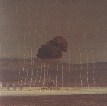 Tumbler Able (40 K)
Tumbler Able (40 K)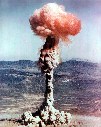 Tumbler Charlie (76 K)
Tumbler Charlie (76 K)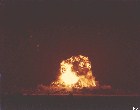 Snapper How (27 K)
Snapper How (27 K)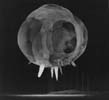 Rope Trick Fireball (26 K)
Rope Trick Fireball (26 K)